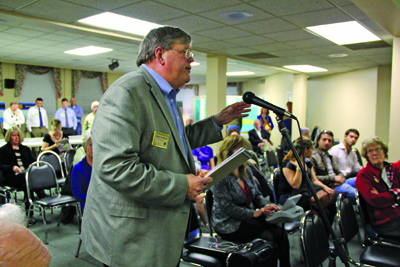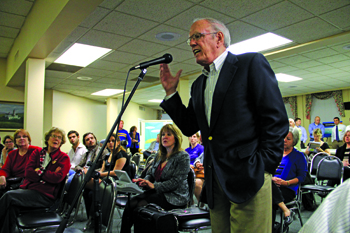Community action results in scope change
Posted on March 5, 2014 By Editor Articles, Neighborhood News, Top Stories
I-10/I-95 and Fuller Warren Bridge expansion reduced –
Last month nearly 200 residents dropped in at Riverside Park United Methodist Church to peruse the aerial views of the proposed I-10/I-95 interchange project (number 433036-1, according to the Florida Department of Transportation).
After the two-hour open house, FDOT Planning and Environmental Manager Bill Henderson spoke to an audience of about 100 people, providing an overview of the project before turning it over for public comment.
The kick-off meeting introduced the Project Development and Environment (PD&E) study for the expansion of the Fuller Warren Bridge over the St. John’s River and an exit ramp from I-10 westbound to Roosevelt Boulevard.

Robin Lumb, Councilman-at-Large and Riverside resident, makes several key points about the expansion project that will affect North Riverside – Photo by Kevin Kuzel
The project has diminished in scope since the early release of the plan in December at the FDOT review of the Tentative Five-Year Work Program for Fiscal Years 2014-2019. At that time the $130-136 million project included expansion over land in North Riverside, threatening the demise of several homes and office buildings.
After meetings with Riverside Avondale Preservation, council members, and other community groups and residents, FDOT has scaled back construction to two primary areas at a reduced cost of $70 million. Those areas are I-10 from McDuff Avenue to I-95 and along I-95 to Kings Avenue.
At the public meeting, Henderson noted that the benefits were substantial savings in travel time resulting in cost benefits. He stated that traffic during morning and afternoon peak travel times in the study area exceeds capacity, which was predicted to be around 210,000 vehicles by 2015, but which is already at 250,000 and expected to increase to 290,000 per day by 2040.
Impacts and eminent domain inevitable
The proposed project does have issues to be overcome, including right-of-way acquisitions and relocation of homes and businesses, and disruption of the weekly Riverside Arts Market under the Fuller Warren Bridge.
According to James Bennett, Urban Transportation Development Manager, the current concept significantly reduces the amount of construction expansion of the current roadways, thereby reducing the potential impacts to the community. “Considerable progress has been made to address key issues such as neighborhood encroachment, operations of the RAM for both short-term (during construction) and long-term (after all construction is completed), etc.” he said in an email distributed the week before the Feb. 10 meeting.
Bennett said that information and concerns from the community prompted them to make modifications to the design, changing shoulder widths in the medians – also referred to as breakdown lanes – from the FDOT standard of 10 feet wide to the national standard of four feet, which is the minimum for four-lane interstate highways.
“The only area [of I-95] we will actually need to widen is over water,” said Bennett. “As we continue to work through and refine the concept with the community’s input, we are not anticipating any right-of-way acquisition over land except for the I-10 westbound flyover to US-17 south.”
Safety a major
concern for local business owner
St. Nicholas-based attorney Fred Isaac, representing Dr. Bshara Barakat, owner of River Park Holdings LLC, spoke about his client’s concerns with the proposed reduced width of the shoulders, noting that the office building at 751 Oak Street is too close to the highway for comfort.
“That building right now is extremely close to the expressway,” said Isaac. “Our concern is safety. What I’ve seen on the engineering plans is that the shoulders on the upper level are going to deviate from Federal Highway Administration
standards. They’re going to deviate in that the outside shoulders will only be 10 feet as opposed to 12 feet and the inside shoulders will only be four feet.”

Preston Haskell, CEO of Haskell Company, speaks against the proposed expansion project of I-10 and I-95 –
Photo by Kevin Kuzel
Isaac further stated that with six lanes of traffic at that point, “that’s a huge confluence of traffic that creates a major, major safety issue. Dr. Barakat doesn’t want a car over in his building. Our concern is safety…if you’re going to do it, do it correctly and put in the appropriate amount of shoulder length and depth as required by the FHA.”
Bicycling community unhappy with absence of path
To the dismay of the bicycling community, the over-water expansion of the bridge does not currently include plans for a protected multi-use bicycle/pedestrian path. FDOT cited Florida Statute 316.091 as prohibitive of a bike lane on the roadway or along the shoulder, including bridges, on limited access facilities and interstate highways.
However, as several residents pointed out, including RAP’s president Jonathan Oliff, there are precedents for a shared-use path over the Fuller Warren Bridge set on other expressways in the state of Florida. He noted areas such as historic Ybor City in Tampa where multi-modal paths are used.
Mark Atkins, president of the North Florida Bicycle Club, which has over 1200 members in and around Jacksonville, supports the creation of a physically separated multi-use path, connecting the urban core.
“It would do something to decrease the growth in automobile traffic and enhance the quality of life in the community, with benefit to local businesses with increased foot traffic,” Atkins said.
Fatality statistics from the National Highway Traffic Safety Administration [NHTSA] ranked Florida number one in bicycle fatalities in 2011 and Duval County in a four-way tie for fourth place in 2012 in the state of Florida [www-nrd.nhtsa.dot.gov]. According to NHTSA, Duval County also ranked fifth in pedestrian fatalities in Florida in 2012.
Alice Gould, manager of World Famous City Cycle on Park Street, encouraged FDOT to take steps forward in improving and supporting the bicycle segment of the community. “It helps the local economy to have people stay in the neighborhood where they live, work and shop. People coming from other cities look for a way to integrate bicycling into their lives and a reason to stay in Jacksonville,” she said.
“I find it very curious that early on in the discussion there was public request about bike lanes,” said Stephen Dare, of MetroJacksonville.com. “Yet something appears on the website about how this would not be legal. And it was bike lanes, when clearly there is provision to allow for multi-use paths which would accommodate bikes. It comes across as a little bit disingenuous, when it would be a fairly easy thing to look at the intent of what the community wanted rather than parsing the words of it.”
The Senator objects
Representing State Senator Audrey Gibson, Dem., was legislative assistant Farisha Hamid, who briefly spoke on the Senator’s behalf, stating that Senator Gibson would like more focus on signage in certain areas, especially the Downtown area, and stated that “Senator Gibson opposes this expansion.”
Lumb and Councilman Jim Love, District 14, plan to be involved with the process. “There are still some things that need to be done in the RFP (request for proposal),” said Love. “It’s a big improvement over the original project brought out, but there is more to happen.”
“This is a very active and engaged community and you will get a lot of feedback on this project,” said Lumb. “We are going to expect the DOT to do what it has to do to make this project conform to what this neighborhood needs.”
To stay up to date on the project go to www.10and95.com.
By Kate A. Hallock
Resident Community News




 (No Ratings Yet)
(No Ratings Yet)




